Maurice Duplessis facts for kids
Quick facts for kids
Maurice Duplessis
|
|
|---|---|
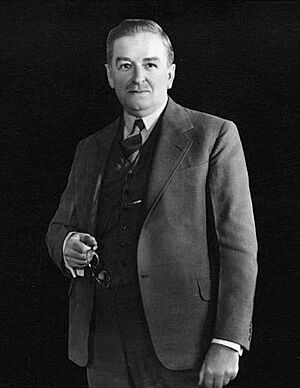
Duplessis in 1947
|
|
| 16th Premier of Quebec | |
| In office August 30, 1944 – September 7, 1959 |
|
| Monarch | |
| Lieutenant Governor | |
| Preceded by | Adélard Godbout |
| Succeeded by | Paul Sauvé |
| In office August 26, 1936 – November 8, 1939 |
|
| Monarch |
|
| Lieutenant Governor | Ésioff-Léon Patenaude |
| Preceded by | Adélard Godbout |
| Succeeded by | Adélard Godbout |
| Attorney General of Quebec | |
| In office August 30, 1944 – September 7, 1959 |
|
| Preceded by | Léon Casgrain |
| Succeeded by | Antoine Rivard |
| In office August 26, 1936 – November 8, 1939 |
|
| Preceded by | Charles-Auguste Bertrand |
| Succeeded by | Wilfrid Girouard |
| Minister of Roads of Quebec | |
| In office July 7, 1938 – November 30, 1938 |
|
| Preceded by | François Leduc |
| Succeeded by | Anatole Carignan |
| Minister of Lands and Forests of Quebec | |
| In office February 23, 1937 – July 27, 1938 |
|
| Preceded by | Oscar Drouin |
| Succeeded by | John Samuel Bourque |
| Member of the Legislative Assembly of Quebec for Trois-Rivières | |
| In office May 16, 1927 – September 7, 1959 |
|
| Preceded by | Louis-Philippe Mercier |
| Succeeded by | Yves Gabias |
| Leader of the Official Opposition of Quebec | |
| In office November 8, 1939 – August 30, 1944 |
|
| Preceded by | Télesphore-Damien Bouchard |
| Succeeded by | Adélard Godbout |
| In office November 7, 1932 – August 26, 1936 |
|
| Preceded by | Charles Ernest Gault |
| Succeeded by | Télesphore-Damien Bouchard |
| 70th President of the Bar of Quebec, Bar of Trois-Rivières | |
| In office 1937–1938 |
|
| Preceded by | Lucien Moraud |
| Succeeded by | Paul Lacoste |
| Personal details | |
| Born |
Maurice Le Noblet Duplessis
April 20, 1890 Trois-Rivières, Quebec, Canada |
| Died | September 7, 1959 (aged 69) Schefferville, Quebec, Canada |
| Resting place | Saint-Louis Cemetery, Trois-Rivières |
| Political party | Union Nationale |
| Other political affiliations |
Conservative Party of Quebec (pre 1936) |
| Parent |
|
| Alma mater | Université Laval de Montréal |
| Profession | Lawyer |
| Signature | |
Maurice Le Noblet Duplessis (April 20, 1890 – September 7, 1959) was a Canadian lawyer and politician. He was known as "Le Chef" (The Boss). Duplessis served as the 16th premier of Quebec.
He was a conservative and nationalist leader. His party, the Union Nationale, was very powerful in provincial politics from the 1930s to the 1950s. Duplessis was Premier for over 18 years. This makes him the longest-serving premier in Quebec history.
Duplessis's time as Premier saw a lot of economic growth. He supported businesses by keeping taxes low and avoiding too many rules. He also tried to limit the power of trade unions. Duplessis strongly believed in provincial autonomy. This meant he often disagreed with the Canadian federal government. He also protected the traditional role of the Catholic Church in Quebec. The Church was very involved in healthcare and education at the time.
Contents
- Maurice Duplessis: Early Life and Education
- Maurice Duplessis: Entering Politics
- Maurice Duplessis: Rise to Power
- Maurice Duplessis: First Term (1936–1939)
- Maurice Duplessis: Return to Power (1944-1959)
- Maurice Duplessis: Death and Legacy
- Maurice Duplessis: Historical Views
- Maurice Duplessis: Commemoration
- Images for kids
Maurice Duplessis: Early Life and Education
Family Background
Maurice Le Noblet Duplessis was born on April 20, 1890. His family lived in Trois-Rivières, Quebec. They were religious and quite wealthy. His father, Nérée Le Noblet Duplessis, was a lawyer. He was also a Conservative member of the Legislative Assembly of Quebec (MLA). An MLA is like a provincial Member of Parliament.
Maurice's father was a busy man. He had close ties with the local bishop. This showed the family's strong connection to the Catholic Church. Maurice's mother, Berthe Genest, had Scottish and Irish family. The Duplessis family was open to English speakers. Maurice even joked that he was "one of them."
School Days
In 1898, Duplessis went to Collège Notre-Dame in Montreal. This was a school run by a religious group. There, he met André Bessette, who later became Brother André. Brother André was a kind person who liked young Duplessis. This friendship led Duplessis to develop a strong devotion to Saint Joseph. This devotion sometimes influenced his political choices later in life.
Maurice was a very smart student. He was excellent in French, history, Latin, and philosophy. But he was also known for being playful and sometimes getting into trouble. In 1902, he moved to the Séminaire de Trois-Rivières. This was a classical college, which means it focused on subjects like Latin, Greek, and philosophy. He continued to be a top student there. He also improved his speaking skills in the debate club.
Duplessis showed an interest in politics from a young age. By age ten, he was already looking at election results. As a teenager, he attended political meetings and talked to voters. He learned that he preferred the practical side of politics.
After school, Maurice thought about becoming a priest or going into politics. He decided against being a priest because he felt it had too many rules. He also wasn't interested in business. In 1910, he enrolled in law school at Université Laval in Montreal. Becoming a lawyer was a common way to enter politics back then. He was known for being lively and good at talking to people. He also enjoyed professional baseball and opera.
Maurice Duplessis: Entering Politics
Becoming a Lawyer
Maurice Duplessis became a lawyer in September 1913. He returned to his hometown of Trois-Rivières to practice law. He first worked with his father. But his father was appointed a judge in 1914. So, Maurice opened his own law firm. He worked with a friend and another lawyer. Duplessis did not serve in World War I because he was exempt from military service.
He mostly practiced civil law, helping regular people with their legal issues. He became known as a skilled and friendly lawyer. He was popular in the town. He also directed a local baseball team. His success allowed him to buy a car, which was a big deal at the time. He stopped practicing law full-time in 1934 when his political duties grew.
First Elections
Duplessis always wanted to be a politician. His first try for the Legislative Assembly was in 1923. He ran as a Conservative in Trois-Rivières. He lost that election, but it was a close race. He hoped this good start would make him a strong candidate for the future.
Four years later, in 1927, Duplessis tried again. He visited many working- and middle-class families. He won the election, becoming an MLA. This was the first time in 27 years that a Conservative won that seat. After his victory, he reportedly said he would be "a future Premier of Quebec."
As an MLA, Duplessis was very active. He spoke out about industrial development and taxes. He also wanted to protect Sundays as a religious day. The Premier at the time, Louis-Alexandre Taschereau, was impressed. He said Duplessis "would go far." Duplessis's strong speaking skills and legal knowledge made him a rising star. He became the unofficial leader of the Conservative group in the Assembly when the official leader, Camillien Houde, was often absent.
In the 1931 election, the Conservatives lost badly again. Duplessis won his seat by a very small number of votes. This showed that the party needed a new direction.
- Quebec politics of 1920s and 1930s
-
Camillien Houde, leader of the Conservative Party of Quebec (1929–1931) and Mayor of Montreal
Maurice Duplessis: Rise to Power
Leading the Opposition
After the 1931 election, the Conservative party was in trouble. Their leader, Camillien Houde, was no longer an MLA. So, on November 7, 1932, Maurice Duplessis became the leader of the Official Opposition. This means he was the main voice against the government in the Legislative Assembly. This choice was confirmed by the party in 1933. Many young members who wanted more power for Quebec supported him.
Quebec was suffering during the Great Depression. The ruling Liberal Party had been in power for over 35 years. Many people were unhappy with their economic policies. Duplessis often questioned the government about their failures. He said they ignored rural areas and focused too much on big businesses. Some Liberal MLAs became unhappy and formed a new party called the Action libérale nationale (ALN).
Forming a Coalition
The ALN was a new political group. It included nationalist and progressive MLAs. They were led by Paul Gouin. This party wanted to improve life for French Canadians. They wanted to expand social programs and help rural areas. They also wanted the government to control electricity companies.
Duplessis was at first unsure about joining forces with the ALN. But the Liberals called a quick election in November 1935. To avoid splitting votes, Duplessis agreed to a coalition. This new group was called the Union Nationale. They ran on the ALN's ideas. The coalition almost won, getting 42 out of 90 seats. Duplessis was reelected easily.
The Union Nationale Takes Over
In spring 1936, Duplessis pushed for an investigation into the government's money. They found many problems. Public money had been used improperly. Newspapers reported every detail, which was great for Duplessis. Premier Taschereau resigned on June 11, 1936, because of the scandals. Adélard Godbout became the new Premier and called an election.
Duplessis was now very popular. Most of the ALN members supported him, not Paul Gouin. On June 17, Duplessis announced he would not renew the coalition agreement. He took over the Union Nationale name for his own party. Gouin left politics. When the election happened, the Union Nationale won a huge victory. They got 76 out of 90 seats. This ended 39 years of Liberal rule in Quebec.
Maurice Duplessis: First Term (1936–1939)
Duplessis immediately started working on his promises. He created the Farm Credit Bureau. This gave low-interest loans to farmers, which was very popular. However, he did not nationalize electricity companies. This made some former ALN members leave his party.
His first term was during the Great Depression. Many people were unemployed. The government spent more on social programs. This caused a big budget problem. Duplessis resisted the federal government's attempts to help. He felt it was against Quebec's provincial autonomy.
His government started giving out old-age pensions. They also approved workplace accident protections. They began Public works projects, like the Montreal Botanical Garden. A new law set a minimum wage for everyone. Before, it only applied to women. They also helped needy mothers, the blind, and orphans. Quebec got its first Ministry of Health during this time.
Duplessis was strongly against trade unions and communism. He introduced the Padlock Law in 1937. This law allowed him, as Attorney General, to shut down properties used for communist propaganda. Because the law was vague, it was often used against anyone seen as an enemy, including trade unions. Other laws made it harder for unions to operate.
On September 1, 1939, World War II began. Duplessis called a quick election. He wanted to rally people against conscription, which many French Canadians opposed. But the Liberals said they were also against conscription. Duplessis's party lost badly, winning only 15 out of 86 seats.
Maurice Duplessis: Return to Power (1944-1959)
Back in Opposition
After his defeat, Duplessis's leadership was in danger. But he managed to keep control of his party. The Liberals, led by Adélard Godbout, introduced some new policies. In 1940, they gave women the right to vote in provincial elections. Duplessis and most of his party voted against this. He worried about increased government spending and election fraud.
In 1943, the Liberals made schooling compulsory for children aged six to fourteen. Duplessis's party also opposed this. They did not enforce it much when Duplessis returned to power. In 1944, Godbout created Hydro-Québec. This was a government-owned company for electricity. Duplessis opposed this too. He thought it was a political trick before the election. He also believed private companies were better at managing electricity.
The 1944 Election
Another new political group, the Bloc populaire, emerged. They were against conscription and wanted more autonomy for Quebec. They also supported nationalizing electricity. This party competed with Duplessis for nationalist votes.
Duplessis's campaign focused on protecting Quebec's interests. He said religious minorities, the federal government, and trade unions threatened Quebec's traditions and identity. He also attacked Godbout's reforms, saying they threatened the Church. Duplessis even spread a false story. He claimed the federal government planned to bring 100,000 Holocaust refugees to Quebec. This story was popular with the public. Businesses liked his promise to support private investments.
In the 1944 election, the Union Nationale got fewer votes than the Liberals. But because the votes were split between the Liberals and the Bloc populaire, Duplessis's party won 48 out of 91 seats. This allowed him to form the government again.
Long Years in Power (1944-1959)
Duplessis's return to power led to 15 years of continuous rule. This was common in Canada after the war. Governments were reelected because of strong economic growth. Duplessis's personal charisma was a big reason for his long rule. He also had a skilled team of campaign managers. His party also got money from businesses. They used this money for lavish campaigns. Threats to withdraw funds from areas that didn't support his party also helped. Support from the Catholic Church also played a role.
Duplessis's rule had some strong tendencies. He was the main decision-maker in parliament. He strictly controlled his party. He also censored things he thought were immoral. Media outlets that supported communists were shut down. Newspapers were told not to report on the Union Nationale's wrongdoings. He also fought against Jehovah's Witnesses. He compared them to Communists and Nazis. However, he lost court cases related to them in the Supreme Court of Canada.
Duplessis's government was socially conservative. The Catholic Church had a huge influence in Quebec. It provided most healthcare and education services. Duplessis was a great speaker. He emphasized French Canadian values: the Catholic faith, local traditions, and the French language. He argued that Quebec needed to protect its provincial autonomy from the federal government. He often refused to join federal-provincial programs. He also successfully asserted Quebec's right to collect its own taxes in 1955.
Quebec's economy grew strongly after the war. There was almost full employment. Wages rose faster than in the rest of Canada. Duplessis encouraged private investment. He attracted money by keeping taxes low and having few regulations. He also had policies that favored employers over workers. Trade unions were a specific target. He passed laws that made it hard for unions to bargain. When strikes happened, like the Asbestos strike in 1949, police were sent to break them up.
Duplessis's government was careful with money. The budget was balanced, and provincial debt decreased. He called most welfare programs "Anglo-Saxon and Protestant socialism." He believed charity should fill the gaps. Ironically, the federal government paid for most welfare in Quebec by the end of his rule. The main investments were in hospitals, schools, and electricity. They also developed rural areas. But rural areas remained poorer than cities. Many people moved from the countryside to Montreal. French Canadians were still generally less well-off than English speakers. English speakers controlled most businesses in Montreal.
Maurice Duplessis: Death and Legacy
Final Years and Death
Duplessis had many health problems throughout his life. He had surgeries and was diagnosed with diabetes. Doctors warned him to rest, but he continued his duties. In September 1959, he traveled to Schefferville to see mines. On September 3, he suffered a stroke. He had more strokes and died on September 7, 1959.
His body was placed in a coffin covered by the flag of Quebec. He had introduced this flag in 1948. His body was brought to Quebec City and then to his hometown of Trois-Rivières. About 100,000 people came to pay their respects. His funeral was attended by many important people. These included the Prime Minister of Canada and other premiers. He was buried next to his parents.
After Duplessis
After Duplessis's death, Paul Sauvé became Premier. His time was known as "désormais" (from now on). He made some reforms. But he also said he was loyal to Duplessis's ideas. After Sauvé died in 1960, Antonio Barrette became Premier. He continued similar policies. However, these changes in leadership weakened the Union Nationale. In the 1960 election, Jean Lesage's Liberals won. This defeat marked the beginning of the Quiet Revolution. This was a period of rapid social and political change in Quebec.
Private Life
Duplessis never married or had children. He often said his only family was the people of Quebec. He lived alone for most of his political life. He was close to his sisters and their husbands. He also became a godfather to a daughter of one of his ministers.
Despite his public image, Duplessis enjoyed opera and literature. He liked historical and political books. He also read classical French and English authors. Later in life, he collected paintings. These paintings were later donated to the National Museum of Fine Arts of Quebec. He didn't play sports, except for croquet. But he was a big fan of the Montreal Canadiens hockey team and the New York Yankees baseball team.
Maurice Duplessis: Historical Views
The "Great Darkness" Idea
Duplessis is a very famous, but also controversial, figure in Canadian politics. Even today, many politicians avoid being compared to him. This is because his rule often has negative meanings in Quebec.
After his death, many people criticized Duplessis. Some said he didn't tax enough, which hurt Quebec's social services. Others said he let foreign companies exploit Quebec. They called him a "Latin-American dictator" who failed to help French Canadians. The Quiet Revolution was seen as a bright contrast to Duplessis's time. His era became known as the Grande Noirceur (Great Darkness). This term suggests he blocked progress and allowed corruption.
Challenging the "Great Darkness"
In the 1970s, some biographies painted Duplessis in a positive light. Robert Rumilly praised his devotion to the Catholic Church. Conrad Black argued that Duplessis was a skilled politician. He believed Duplessis modernized Quebec while keeping traditional values. Black suggested that Duplessis's policies helped Quebec's prosperity.
Later researchers in the 1980s and 1990s also questioned the "Great Darkness" idea. They argued that Quebec was developing like the rest of North America. They said the Church's influence was not as important as once thought. Some even argued that Duplessis's government was actually modern in its economic views. They said he supported economic progress and capitalism.
Today, many historians believe the Grande Noirceur was a myth. They say it was created by those who led the Quiet Revolution. They argue that Duplessis's era was not unique. Other governments in Canada and New Zealand had similar policies. These included resisting welfare, being anti-communist, and focusing on rural development. Some historians even call his time the "Great Catch-Up." They see it as a period of progress for Quebec.
Comparisons to Other Leaders
Historians have compared Duplessis to many other leaders. Some saw similarities with Huey Long from the US and Juan Perón from Argentina. This was because of their strong leadership styles. Some compared his rule to an "authoritarian democracy." This means a system where there are elections, but the leader has a lot of power.
Others compared him to Éamon de Valera in Ireland. Both leaders were strong nationalists. Some also saw similarities with Joh Bjelke-Petersen, a premier in Australia. Both used strong tactics against unions and communists. They also had strong anti-federalist views. Duplessis's anti-communism was also compared to US Senator Joseph McCarthy.
In Quebec, some politicians have been compared to Duplessis. Mario Dumont and his Action démocratique du Québec (ADQ) party were seen as similar. They focused on provincial autonomy and used popular language. More recently, Quebec's current premier, François Legault, has been compared to Duplessis. His party, the Coalition Avenir Québec, has been likened to the Union Nationale. Legault himself has said his party resembles the Union Nationale. He has also defended some aspects of Duplessis's legacy in parliament.
Maurice Duplessis: Commemoration
In Quebec Culture
After Duplessis died, politicians tried to keep his memory alive. A provincial electoral district was named Duplessis in 1960. A major road in Quebec City was also renamed after him. Another road in Montreal was named Boulevard Maurice-Duplessis in 1967.
The government wanted to build a statue of him. But the new government of Jean Lesage hid it. They said it was to avoid political tensions. So, the first statue of Duplessis was put up in 1964 in Trois-Rivières. It was done by a private group dedicated to his legacy. This group also keeps his private collections and archives.
As the Quiet Revolution continued, people's views of Duplessis became more negative. But in the 1970s, more books about him appeared. A successful play about the Asbestos strike, Charbonneau et le Chef, was performed. Filmmaker Denys Arcand also made films and a TV series about him. These works were quite fair to Duplessis. In 1974, Parks Canada recognized Duplessis as a Person of National Historic Significance. In 1977, Premier René Lévesque finally put the hidden statue next to the Parliament Building.
- Landmarks associated with, or named after, Maurice Duplessis
-
Sept-Îles is the largest city within the provincial riding of Duplessis, located in the Côte-Nord region of Quebec.
In the 1980s, negative views of Duplessis continued in the arts. A documentary in 1997, Les Orphelins de Duplessis, revealed abuses against the Duplessis Orphans. This further strengthened the idea of his era as the "Great Darkness."
In the 21st century, the negative image of his era largely remains. Student protests in 2012, known as "Maple Spring", even compared government actions to Duplessis's time. A brewery makes a dark beer called Grande Noirceur (Great Darkness). Its label shows a cartoon Duplessis controlling people like puppets, with churches in the background.
Awards and Titles
Duplessis received many honors during his life. In 1931, he was named King's Counsel for his legal work. He was also President of the Bar of Quebec and the Bar of Trois-Rivières. This gave him influence in the legal community. Several universities gave him honorary degrees.
He also received decorations. In 1948, the President of Argentina gave him a high award. He also received a golden star for his contributions to agriculture. He was inducted into the Order of Saint John.
Images for kids


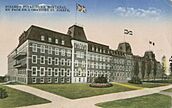
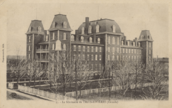
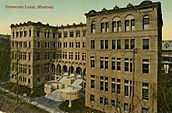

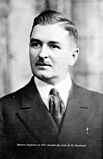
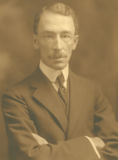
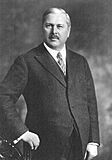
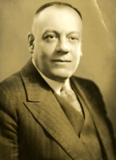


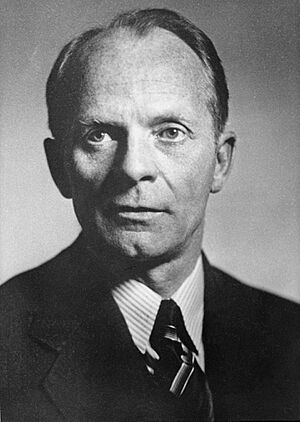
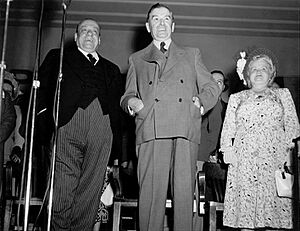
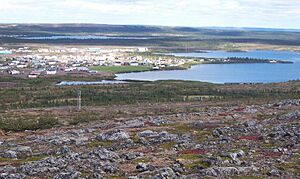
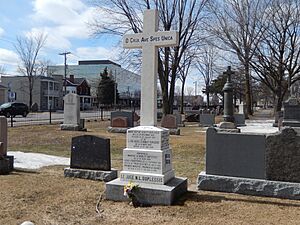

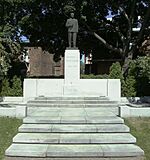
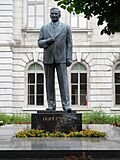


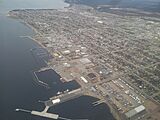
![The interior part of Maurice Duplessis Bridge [fr], located near Villebois, Quebec. Apart from this, several streets, parks and other objects across the province are named in his honour](/images/thumb/a/a4/Pont-maurice-duplessis-beaucanton.jpg/160px-Pont-maurice-duplessis-beaucanton.jpg)




